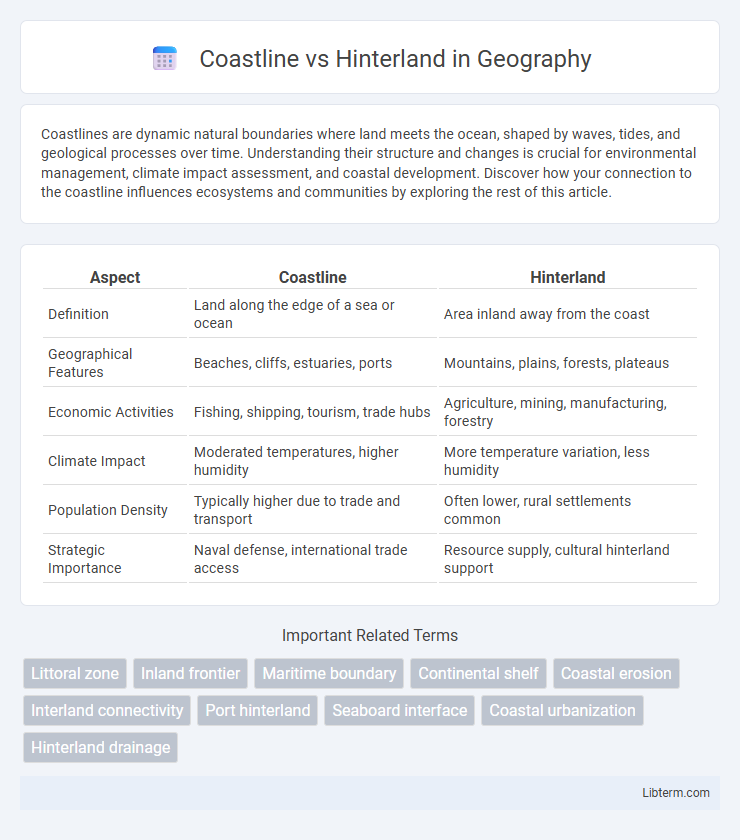Coastlines are dynamic natural boundaries where land meets the ocean, shaped by waves, tides, and geological processes over time. Understanding their structure and changes is crucial for environmental management, climate impact assessment, and coastal development. Discover how your connection to the coastline influences ecosystems and communities by exploring the rest of this article.
Table of Comparison
| Aspect | Coastline | Hinterland |
|---|---|---|
| Definition | Land along the edge of a sea or ocean | Area inland away from the coast |
| Geographical Features | Beaches, cliffs, estuaries, ports | Mountains, plains, forests, plateaus |
| Economic Activities | Fishing, shipping, tourism, trade hubs | Agriculture, mining, manufacturing, forestry |
| Climate Impact | Moderated temperatures, higher humidity | More temperature variation, less humidity |
| Population Density | Typically higher due to trade and transport | Often lower, rural settlements common |
| Strategic Importance | Naval defense, international trade access | Resource supply, cultural hinterland support |
Introduction to Coastline and Hinterland
Coastlines represent dynamic interfaces between land and sea, featuring unique ecosystems and economic activities such as ports, fisheries, and tourism that drive regional development. Hinterlands refer to inland areas extending from the coastlines, often characterized by agricultural production, resource extraction, and trade networks supporting coastal urban centers. Understanding the interplay between coastlines and hinterlands is essential for optimizing spatial planning, resource management, and sustainable development strategies.
Defining Coastline: Key Features and Characteristics
The coastline represents the dynamic boundary where land meets the ocean, characterized by features such as beaches, cliffs, estuaries, and tidal zones. It is shaped by processes like erosion, deposition, and tidal actions, resulting in diverse landforms and unique ecosystems. Key characteristics include high biodiversity, vulnerability to sea-level rise, and significant economic importance due to ports, tourism, and fisheries.
Hinterland Explained: What Lies Beyond the Shore
The hinterland refers to the inland area lying beyond the immediate coastal strip, often characterized by its link to the coastline through economic and geographical connections. It serves as a vital region for agriculture, resource extraction, and trade, supporting ports and coastal cities by providing raw materials and markets. Understanding the hinterland is crucial for regional planning, transportation networks, and sustainable development strategies that balance economic growth with environmental conservation.
Geographical Differences Between Coastline and Hinterland
The coastline features sandy beaches, cliffs, and tidal zones influenced by saltwater and marine weather patterns, while the hinterland consists mainly of inland terrains such as forests, plains, and mountains with freshwater ecosystems. Coastal areas often exhibit higher humidity, saline soils, and diverse marine biodiversity, contrasting with the hinterland's varying climate zones and terrestrial flora and fauna. Human settlements along the coastline tend to focus on fishing, tourism, and trade, whereas hinterland communities rely more on agriculture, forestry, and mining.
Economic Importance: Maritime vs Inland Activities
Coastlines drive economic growth through maritime activities such as shipping, fishing, tourism, and port operations that facilitate international trade and create jobs. Hinterlands contribute significantly via agriculture, mining, forestry, and manufacturing, supporting local economies with raw materials and industrial production. The interdependence between coastal and inland regions enhances national economic stability by linking export hubs with resource-rich interior zones.
Biodiversity and Ecosystems: Comparing Land and Sea Influences
Coastlines harbor unique ecosystems influenced by both marine and terrestrial biodiversity, supporting species adapted to saline and fluctuating environments, such as mangroves and salt marshes. Hinterlands exhibit diverse terrestrial habitats with stable freshwater sources, enabling complex forest and grassland ecosystems that host large mammals and endemic flora. The dynamic interaction between coastal saline systems and inland freshwater ecosystems creates transitional zones rich in biodiversity and critical ecological processes.
Human Settlements: Population Distribution Patterns
Coastline settlements typically exhibit higher population densities due to access to maritime resources, trade routes, and favorable economic opportunities, fostering urban development and diverse communities. Hinterland areas generally show lower population densities with scattered settlements influenced by agricultural suitability, resource availability, and transportation infrastructure. These contrasting patterns shape regional demographics, economic activities, and spatial organization of human populations.
Tourism Trends: Coastal Attractions vs Hinterland Adventures
Coastal attractions dominate tourism trends with beach resorts, water sports, and vibrant marine ecosystems drawing millions annually. Hinterland adventures offer unique experiences through hiking trails, wildlife safaris, and cultural heritage tours, appealing to eco-tourists and adventure seekers. Growth in sustainable tourism is driving balanced development, encouraging visitors to explore both lush inland landscapes and scenic shorelines.
Environmental Challenges: Unique Issues Facing Each Region
Coastline regions face environmental challenges such as rising sea levels, coastal erosion, and saltwater intrusion threatening ecosystems and infrastructure. Hinterland areas struggle with deforestation, soil degradation, and biodiversity loss due to agricultural expansion and mining activities. Both regions require tailored conservation strategies to address their distinct ecological vulnerabilities and sustain natural resources effectively.
Future Perspectives: Sustainable Development in Coastline and Hinterland
Future sustainable development in coastlines hinges on balancing urban growth with ecosystem preservation, incorporating renewable energy, and improving climate resilience in response to rising sea levels. Hinterland regions focus on sustainable agriculture, forest management, and infrastructure development that minimizes environmental impact while enhancing economic opportunities. Integrating smart technologies and community-driven planning across both areas promotes resilience and long-term ecological health.
Coastline Infographic

 libterm.com
libterm.com